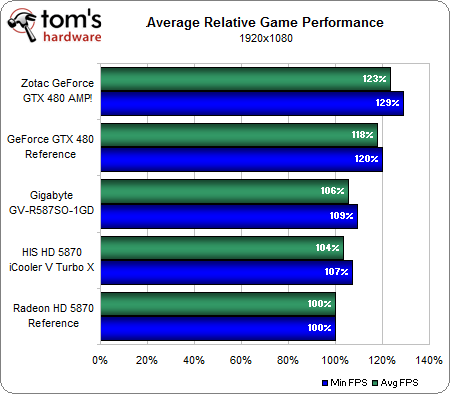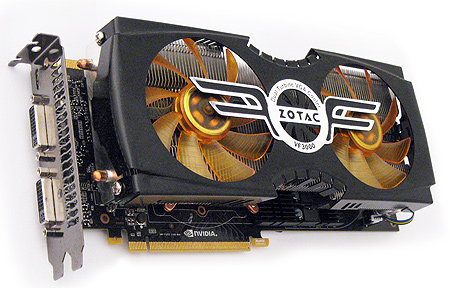Three Factory-Overclocked, High-End Graphics Cards
Why buy a standard model when you can get the top-of-the-line? Treat yourself to the good stuff! We take three premium graphics cards for a spin to see just what kind of optional extras you can get when purchasing a factory-tweaked non-reference board.
Conclusion
There are certainly lessons to be learned here, but those lessons aren't exactly what we were expecting. Compared to the reference cards, these factory-overclocked models rarely deliver a sizable performance increase, even when overclocked to eyebrow-raising heights. As a percentage of the stock clock rates, these overclocks aren't enormous, and there's a fair chance that taking full advantage of an already already high-end overclocked GPU requires a monster of a platform to truly shine.
However, there are certainly other compelling reasons to consider these premium factory-overclocked models. Let's go over each product to discuss their strengths and weaknesses.
HIS HD 5870 iCooler V Turbo X
HIS delivers a strong contender in its HD 5870 iCooler V Turbo X. It's hard to argue with a bundled $50 game, a modified PCB, and improved onboard components, but this HIS card fails to deliver the critical voltage adjustment, cooling performance, and noise reduction we were expecting with the $490 price tag. Moreover, when a card is set to BIOS-based aftermarket frequencies, we'd like to retain the best possible idle clocks, too. In the case of the Radeon HD 5870, that'd be 157/300 MHz.
While we can't stand behind the Turbo X, we have to point out that HIS offers a compelling product in the HIS HD 5870 iCooler V Turbo. Notice the lack of “X” at the end. The regular Turbo version can be found for as little as $420, yet the card appears to be identical to the Turbo X, aside from a mere 25 MHz drop in core clock speed. This standard Turbo edition sports the exact same 1225 MHz memory clock speed and even the same Call of Duty: Modern Warfare 2 game bundle. And we doubt you'd be able to perceive a performance difference between the two models. HIS' standard Turbo version is a Radeon HD 5870 model we can more readily consider.
Gigabyte GV-R587SO-1GD SUPER OVERCLOCK
Gigabyte delivers the ultimate Radeon HD 5870 with its no-holds-barred GV-R587SO-1GD. The $500 purchase price gets you an extremely quiet and cool product, and our test card was able to achieve in excess of 1 GHz on its core thanks to the voltage adjustment option in Gigabyte's OC Guru utility.
Get Tom's Hardware's best news and in-depth reviews, straight to your inbox.
The only downside to this card is cost. Our benchmarks show relatively little performance increase over a reference Radeon HD 5870, even when pushed to over 1 GHz. And that $500 price tag brings the card extremely close to the GeForce GTX 480 that bests it most of the time.
Yet, there is a case to be made for Gigabyte's ultimate Radeon HD 5870, a card that uses far less power than the GeForce GTX 480 and runs much cooler and quieter than the competition. It can also deliver usable Eyefinity-based connectivity, while the GTX 480 is limited to two display outputs. If these strengths appeal to you, then the GV-R587SO-1GD might be the card you want.
Zotac GeForce GTX 480 AMP! Edition
If you take a $450 GeForce GTX 480 reference card and add the upcoming $50 Zalman VF3000F cooler to it, what do you get? The $510 Zotac GeForce GTX 480 AMP! Edition. Back when we received this card, GeForce GTX 480s were $500, making the aftermarket version a veritable steal for $10 extra. Now the value is a little diluted.
Even still, the Zalman cooler fixes a good chunk of the criticism that the GeForce GTX 480 faces in the way of noise and high GPU temperatures. The extra $10 saves you from having to tear Nvidia's reference cooler off (risking delicate memory ICs in the process) and attach the Zalman unit. We still consider that a win. And, it comes with a five-year warranty.
The only ding we have to apply here is the fact that reference Radeon HD 5870s can be had for over $120 cheaper than this card. And from our benchmarks, we can see that it's rare that the GeForce GTX 480 is worth such a gaping spread. Having said that, the GeForce GTX 480 certainly does have its strengths, and if your desires include CUDA, PhysX, and 3D Vision, then this card is a very attractive option. If you are considering a GeForce GTX 480, the Zotac AMP! edition is a particularly strong choice. Just make sure you have the available clearance around this card, as it consumes three slots worth of motherboard space.
Don Woligroski was a former senior hardware editor for Tom's Hardware. He has covered a wide range of PC hardware topics, including CPUs, GPUs, system building, and emerging technologies.
-
knutjb Good to see sensible conclusions, bang for the buck.Reply
Amazing how well the ATI cards are doing given their time on the market. -
Jax69 i am amazed by ati cards after one year on the market is still strong as hell. very good amdReply -
jonsy2k I'm not liking the trend of these cards consuming more and more pci slots to be honest.Reply -
h83 So, the conclusion is that the only good point about those factory overclocked cards are their coolers...Reply -
Tamz_msc ReplyAliens vs. Predator favors the Radeons, just like Crysis favors the GeForce cards. However, the playing field remains very close
The graphs tell otherwise.
-
The Lady Slayer It's a shame the Big Green has paid off so many game developers that we'll never see a 'true' comparison between ATI & nVidiaReply



